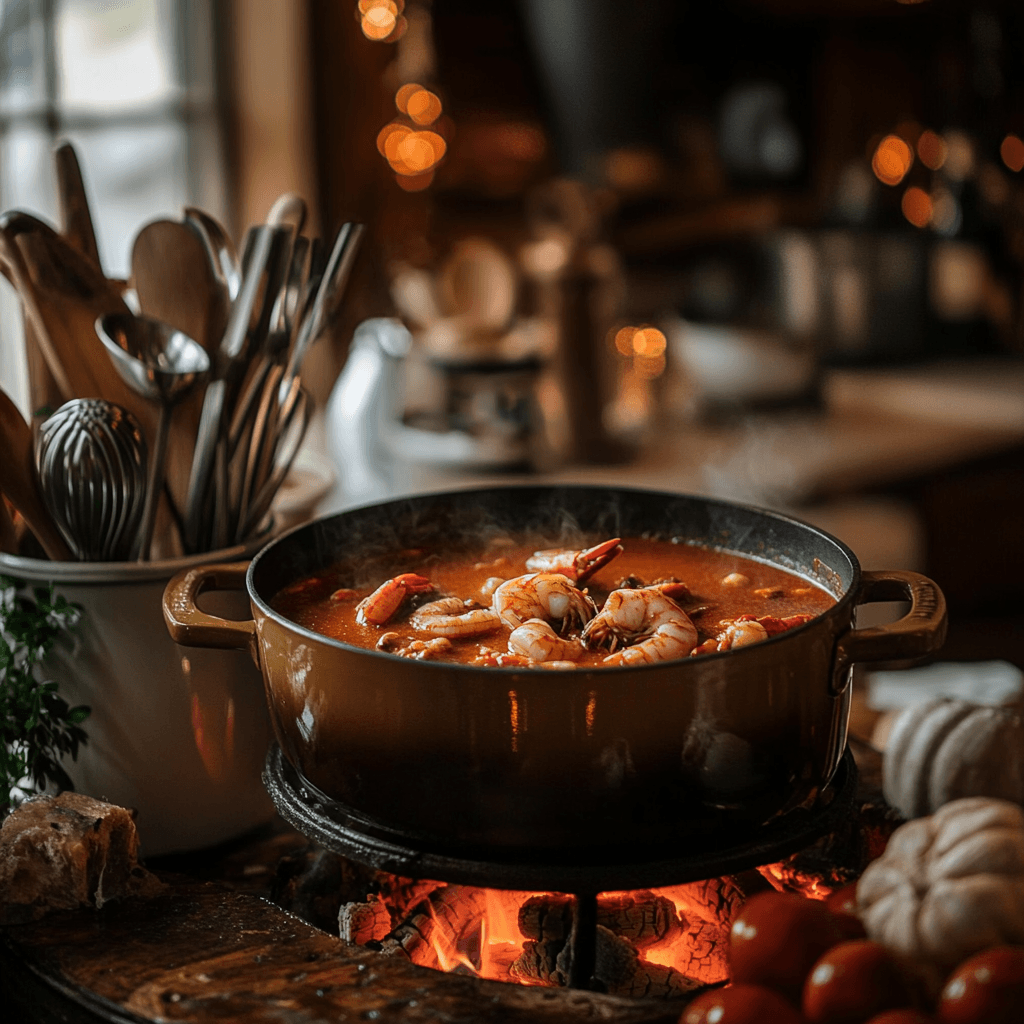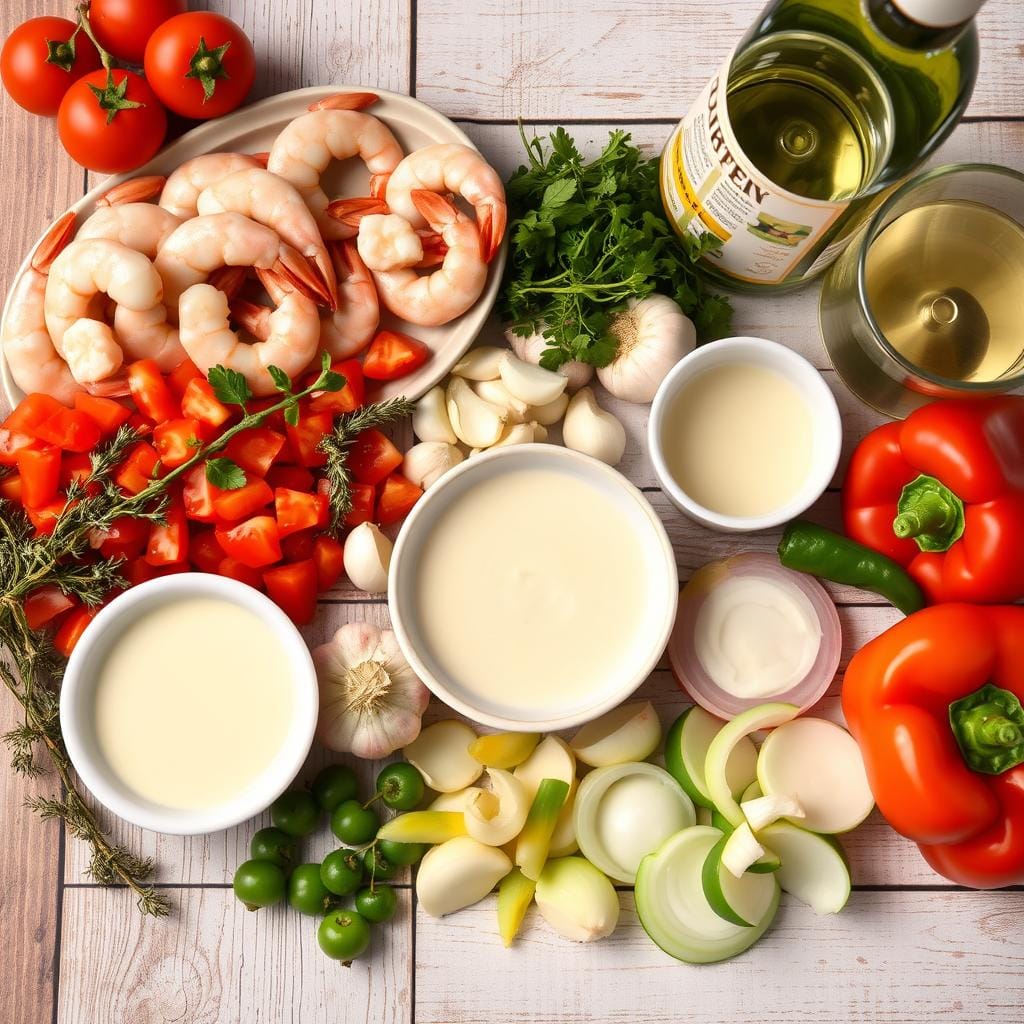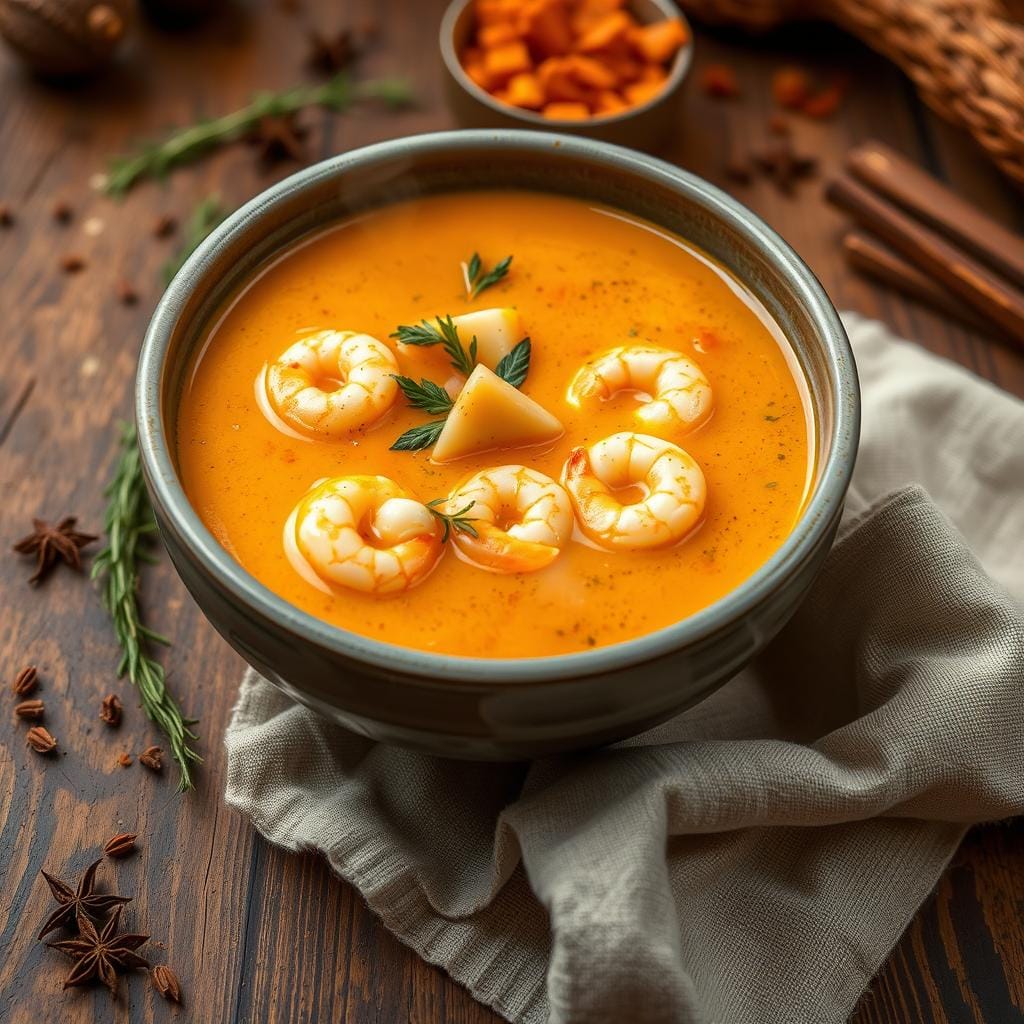Growing up by the Gulf Coast, I found a special seafood soup. It took me back to family gatherings and beach memories. Shrimp and crab bisque is more than food; it’s a journey to the coast. It mixes tasty shellfish with a smooth base that warms you up.
This creamy bisque is a tribute to the sea and its traditions. Each spoonful shares stories of ocean harvests and cooking passed down through generations. The mix of shrimp and crab makes a bisque that turns simple ingredients into a special meal.
If you love cooking or just enjoy trying new foods, this recipe is for you. It will help you make a dish as good as a restaurant’s in your own kitchen. Get ready to dive into a world of flavors that turns simple seafood into a gourmet dish.
Key Takeaways
- Discover the rich heritage of coastal seafood cuisine
- Learn how to create a perfect creamy bisque at home
- Understand the art of balancing seafood flavors
- Explore the emotional connection behind traditional recipes
- Master techniques for a velvety smooth shellfish soup
Understanding the Rich History of Seafood Bisque
Seafood bisque is a journey through coastal cuisine, starting with French fishermen’s kitchens. It has grown from a simple meal to a fancy dish loved around the world.

The tale of bisque starts in France’s coastal areas. Chefs there found ways to bring out seafood flavors. They used crushed shellfish shells to make a creamy base, key to New England bisque.
Origins in French Coastal Cuisine
In French coastal towns, chefs made bisque to use all parts of the seafood. They ground shellfish shells and simmered them to get the best flavor. This method is still used today in bisque recipes.
- Originated in coastal fishing villages
- Developed from necessity and resourcefulness
- Utilized entire shellfish, including shells
Evolution of Modern Bisque Recipes
Chefs started to play with bisque recipes as cooking got better. They added new ingredients and techniques, making bisque a fancy soup.
“Bisque is not just a soup, it’s a culinary art form that captures the essence of coastal cooking.” – Chef Marie Laurent
Cultural Significance in Coastal Regions
Seafood bisque is more than a meal; it’s a cultural icon in coastal areas. From Brittany’s rocky shores to New England’s harbors, it shares stories of sea and kitchen creativity.
Essential Ingredients for the Perfect Shrimp and Crab Bisque
To make a top-notch shellfish bisque, you need to pick the right ingredients. These ingredients turn simple seafood into a rich, decadent bisque. Start by choosing the best parts to make your dish deep and flavorful.

- Fresh shrimp and crab meat
- High-quality seafood stock
- Heavy cream
- Aromatic vegetables
- Seasonings and herbs
When making your bisque, focus on the quality of your ingredients. Fresh seafood is crucial for the best taste.
| Ingredient Category | Recommended Options | Flavor Profile |
|---|---|---|
| Seafood | Blue crab, Gulf shrimp | Sweet, delicate |
| Aromatics | Shallots, garlic, celery | Robust, complex |
| Herbs | Thyme, parsley, chives | Fresh, bright |
“The secret to an incredible bisque is balancing flavors and respecting each ingredient’s natural essence.” – Chef Martin Picard
Your bisque needs careful attention. Choosing the best ingredients will make your shellfish bisque unforgettable. It will wow even the pickiest eaters.
Selecting Quality Seafood for Your Bisque
Creating a great seafood medley begins with picking the freshest shellfish. Your coastal cuisine experience will shine with top-notch ingredients. These will make your shellfish bisque truly stand out.
The quality of your seafood is key to your bisque’s taste and texture. Chefs know that choosing the right ingredients is an art. It requires careful attention to detail.
Choosing Fresh Crab Meat
- Look for bright white or light pink meat with minimal discoloration
- Seek fresh crab from reputable seafood markets
- Check for a clean, ocean-like smell without fishy odors
- Prefer fresh-caught over frozen when possible
Picking the Best Shrimp
- Select firm, translucent shrimp with a slight sea-fresh scent
- Avoid shrimp with black spots or a strong ammonia smell
- Choose wild-caught shrimp for more robust flavor
- Inspect shells for any signs of deterioration
Seasonal Considerations for Shellfish
Different shellfish are at their best at different times of the year. Knowing when they’re in season helps you pick the tastiest ingredients for your coastal cuisine.
“The ocean’s bounty changes with the seasons, and so should your seafood selection.” – Coastal Cooking Experts
Summer is the best time for fresh crab and shrimp. It’s perfect for making your ideal shellfish bisque.
Professional Techniques for Creating Creamy Shellfish Base
Making a top-notch creamy bisque needs some special skills. It starts with getting deep flavors from seafood shells. This turns simple ingredients into a fancy seafood soup.
“The secret to an extraordinary bisque lies in developing deep, rich flavors from the very foundation of your recipe.”
Professional chefs know how to make a great shellfish base. They follow a few key steps:
- Roasting shellfish shells to intensify flavor profiles
- Creating a concentrated seafood stock
- Developing a smooth, velvety texture
- Balancing delicate seafood nuances
The main trick is to simmer crab and shrimp shells slowly. This lets their flavor mix into your creamy bisque.
| Technique | Purpose | Flavor Impact |
|---|---|---|
| Shell Roasting | Intensify Seafood Flavor | Rich, Deep Taste |
| Slow Simmering | Extract Maximum Essence | Complex Flavor Profile |
| Straining | Achieve Smooth Texture | Silky Consistency |
Pro tip: Use heavy cream carefully to keep the seafood flavors bright. It also adds a rich, creamy feel.
With these expert techniques, your homemade seafood soup will shine. It will taste like it’s from a fancy restaurant, impressing everyone.
Making Your First Shrimp and Crab Bisque at Home
Making a decadent bisque at home might seem hard, but it’s doable with the right help. This guide will show you how to make a tasty shrimp and crab bisque. It’s sure to wow your dinner guests.
Essential Preparation Steps
Start by getting all your ingredients and tools ready. A great seafood soup needs careful prep and focus.
- Clean and devein fresh shrimp
- Pick through crab meat for shell fragments
- Chop aromatics like onions and garlic
- Measure out cream and seafood stock
Cooking Timeline
| Stage | Time Required | Key Actions |
|---|---|---|
| Preparation | 15-20 minutes | Chopping, cleaning seafood |
| Sautéing | 10 minutes | Cooking aromatics and seafood |
| Simmering | 20-25 minutes | Developing rich flavors |
| Blending | 5-10 minutes | Creating smooth bisque texture |
Common Mistakes to Avoid
When making your shrimp and crab bisque, avoid these mistakes:
- Don’t overcook seafood, or it will be tough
- Remember to make a roux to thicken the bisque
- Use fresh, high-quality seafood
- Season well to bring out the flavors
“The secret to an exceptional bisque lies in using the freshest ingredients and taking your time during preparation.” – Coastal Cuisine Expert
With practice, you’ll make a creamy, flavorful seafood soup that’s as good as any restaurant’s. Remember, patience and focus are key to making the perfect shrimp and crab bisque.
Secret Tips for Achieving the Perfect Bisque Texture
Making a top-notch creamy bisque is more than just a recipe. It’s the texture that turns a simple shellfish bisque into a gourmet delight.
“The secret to a perfect bisque lies in its silky smooth consistency and rich, developed flavors.” – Culinary Expert
Getting the perfect texture is key. Chefs use several techniques to achieve it:
- Use a high-powered blender for a smooth base
- Double-strain the bisque for extra smoothness
- Add heavy cream slowly to control thickness
- Keep the heat low during final steps
Patience and precision are crucial for a luxurious soup. Start by finely chopping your shellfish. Use a fine-mesh strainer to get that creamy texture.
| Technique | Impact on Texture | Pro Tip |
|---|---|---|
| Blending | Removes lumps | Blend in short pulses |
| Straining | Ensures smoothness | Use multiple passes |
| Cream Addition | Creates richness | Add slowly while stirring |
Pro chefs know that texture is the soul of a great bisque. Your goal is a velvety smooth consistency that coats the spoon perfectly.
Wine Pairing and Serving Suggestions
Enhancing your New England bisque experience is more than just the recipe. The right wine and presentation can turn a simple dish into a memorable meal.
Choosing the perfect wine is key to balancing your seafood medley. The light flavors of shrimp and crab bisque need careful wine selection.
Complementary Wine Selections
Your bisque goes well with certain wines:
- Chardonnay: Its buttery notes match creamy seafood
- Sauvignon Blanc: Its crisp acidity cuts through the bisque
- Pinot Grigio: Its light and refreshing taste pairs well with shellfish
Garnishing Ideas
Enhance your coastal cuisine with these garnish ideas:
- Fresh chives add color and a mild onion taste
- Micro herbs bring an elegant touch
- Delicate croutons add a nice texture
Ideal Serving Temperature
Temperature is crucial. Serve your New England bisque at 160-170°F. This temperature enhances flavor and keeps it warm without losing the seafood’s delicate taste.
“A perfectly served bisque is a symphony of temperature, texture, and taste.” – Chef Maritime
Storing and Reheating Your Seafood Bisque
Keeping your creamy bisque fresh is all about how you store and reheat it. With the right steps, your shrimp and crab bisque can stay tasty for days.
Storing your seafood soup right is key. Here’s how to keep it fresh:
- Cool the bisque completely before storing
- Use airtight containers with tight-fitting lids
- Refrigerate within two hours of cooking
- Store for maximum 3-4 days in the refrigerator
When you reheat your soup, do it gently. High heat can ruin the texture of the seafood and cream.
“Low and slow is the golden rule for reheating creamy bisque” – Professional Chef Recommendation
Here are some good ways to reheat your soup:
- Stovetop method: Warm over low heat, stirring constantly
- Microwave technique: Use 50% power, stirring every 30 seconds
Want to get better at cooking seafood? Check out this comprehensive seafood recipe guide.
Pro tip: Never freeze a cream-based seafood soup, as it can significantly alter the texture and flavor.
Variations and Regional Adaptations
Exploring coastal cuisine shows us how the classic New England bisque is reimagined. Each region adds its own twist, making this dish a true culinary adventure.
Different coastal areas have their own take on seafood bisque. They use local ingredients and cultural flavors to make it their own:
- Gulf Coast Style: Adds spicy Cajun seasonings and local gulf shrimp
- Pacific Northwest Adaptation: Uses Dungeness crab and adds smoky notes
- Florida Keys Version: Includes tropical herbs and a lighter cream base
These regional twists show how versatile this dish is. Chefs try new ingredients while keeping the core of a rich, creamy seafood soup.
| Region | Unique Ingredient | Flavor Profile |
|---|---|---|
| New England | Fresh Atlantic Crab | Classic, Creamy |
| Louisiana | Cayenne Pepper | Spicy, Bold |
| California | Fresh Herbs | Light, Aromatic |
“A great bisque tells a story of its homeland, one spoonful at a time.” – Chef Marcus Samuelsson
Exploring regional bisque variations takes you on a journey through coastal traditions. It shows how a single recipe can change and celebrate the diversity of American seafood cuisine.
Conclusion
Making a seafood soup like shrimp and crab bisque turns a simple meal into a fancy dining experience. You’ve learned how to pick the best seafood, its rich history, and how to make this fancy dish. Now, you’re ready to go from a beginner to a pro at making bisque.
Seafood soup is a world full of possibilities for creativity and discovery. Try adding your own touches to make your shrimp and crab bisque special. With the tips from this guide, you’ll feel confident making a gourmet soup at home.
Your new cooking skills will lead to exciting adventures in the kitchen. Whether it’s for a fancy dinner party or a cozy family meal, your seafood soup will wow everyone. Check out our professional cooking resources for more tips and recipe ideas. Your love for cooking will keep growing and changing your meals.
Every famous chef had to start somewhere. The secret to getting better is to keep practicing, be patient, and love good food. Your journey with shrimp and crab bisque is just starting, and you’re in for a treat.

